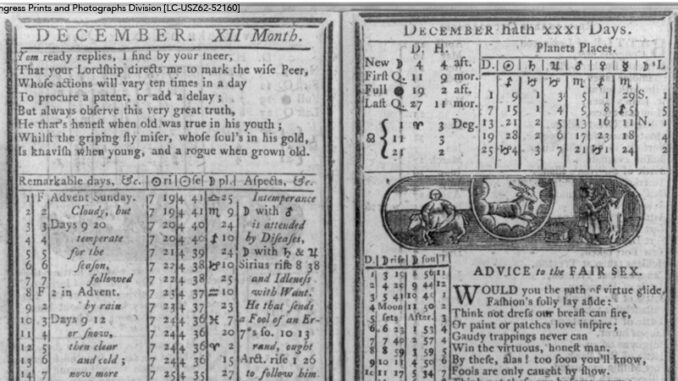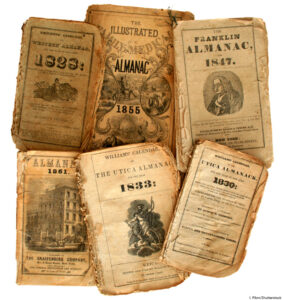
Grab your coat, and get your hat! With winter approaching in North America, The Old Farmer’s Almanac predicts a cold and long winter. Have you heard of The Old Farmer’s Almanac? This week btw will examine the history of The Old Farmer’s Almanac, and why it serves as a reliable reference for weather.
The Almanac’s History
Almanac is an Arabic word that means “climate.” An almanac contains astronomical and meteorological data for a given year, including the rising and setting of the sun, tide information, and weather.
First published in 1792 by Robert B. Thomas, The Farmer’s Almanac, was intended—as the name suggests—as a guide for farmers. It gave predictions about weather patterns and planting schedules. It also included some light humor that made it interesting to read as well. It was released annually beginning at a yearly price of six pence (about nine cents).
In 1832, Thomas changed the name by adding “Old” to the title in order to distinguish it from the many other almanacs that had popped up over the years. One of the other famous almanacs was Poor Richard’s Almanack published by Benjamin Franklin. However, in 1836, Thomas dropped the “Old” because he didn’t want the publication to be thought of as out-of-date. Changing his mind again, in 1848 Thomas added “Old” back in the title. He wanted it known that the periodical was the oldest publication of its kind in North America, and that it had been published continuously without missing a single year.
Murder and Espionage
A couple of lesser known facts about the almanac are intriguing.
Before Abraham Lincoln was president, he was a lawyer. During the Illinois murder trial of William “Duff” Armstrong in the spring of 1858, Lincoln used the almanac to dispute a prosecution witness, Charles Allen. Allen testified that he witnessed Armstrong strike the victim. When asked how he could have seen this when he was about 150 feet away and it was the middle of the night, Allen said, “By the light of the moon.”
Lincoln, then, opened the 1857 almanac to the calendar pages to the day of the murder. He showed the jury that Allen’s testimony couldn’t be true given that the moon was in the first quarter and was low on the horizon. He showed that the moon was about to set at the exact time of the murder. Lincoln argued that there could not have been enough moonlight to see what Allen claimed he saw. The judge agreed and Armstrong was acquitted.
In 1942, an incident occurred that might have interrupted the almanac’s claim of being the longest continuously published periodical. At the height of World War II, a German spy was captured on Long Island. In his pocket was a copy of the almanac. The war department was alarmed. It was concerned that Germany might use the almanac’s long-term weather forecasts to plan an attack on U.S. soil. The almanac got around this concern by renaming the “Weather Forecasts” section to “Weather Indications.”
Planting Seeds for Thought
Farmers aren’t the only people who use the almanac. The almanac also suggests the best time to potty train children, how to deter deer from your garden, and ways to get rid of unwanted critters in your home. There are sections for gardening, food and recipes, home and health, and, of course, weather and astronomy.
In addition to The Old Farmer’s Almanac, today there are hundreds of different kinds of almanacs that focus on sports, satire, and astrology, among others.
What made Thomas’s almanac different? No one knows for certain why it gained more popularity than other almanacs; however, the weather predictions Thomas made were based on a complex series of natural cycles to come up with a weather forecasting formula that is 80 percent accurate.
Despite the almanac’s accuracy, there is mystery surrounding the weather predictions. Some believe that rather than a formula, many of the predictions are based on folklore. For example, the more acorns on the ground in autumn, the longer the winter. A tough apple skin and thick layers of a corn husk are other predictors for a hard winter, while a thin onion skin indicates a mild winter.
Today, however, predictions are made by satellite data and scientific disciplines: solar science (activity on the sun, specifically, sunspots), climatology, and meteorology. So, if you’re planning anything that might be affected by weather, you may want to consult The Old Farmer’s Almanac. After all, at 80 percent accuracy, how could you go too wrong?

